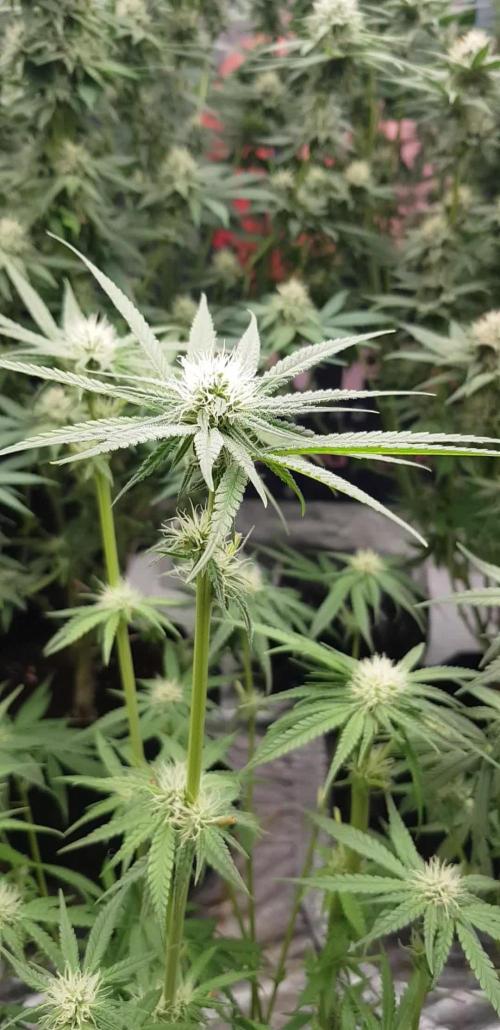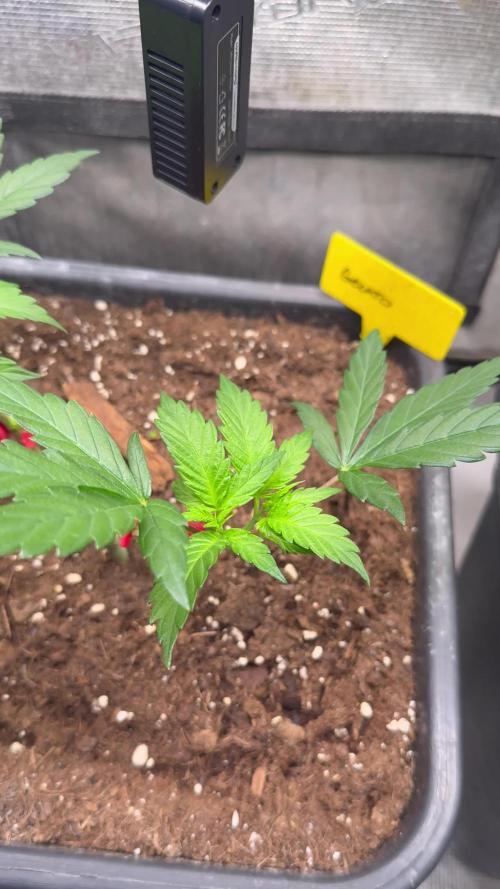The Grow Awards 2026 🏆 

































Likes
Comments
Share


@Tetiana_Riz
Follow
Hello everyone. Another week has come to an end, and for two weeks, we have been watering our girl with plain water pH 6.2 TDS 120 ppm. I think next week we will finish our journey. I want to experiment - 2-3 days without light and with reduced temperature. Share your opinion on my experiment.
Likes
3
Share


@Lazuli
Follow
This was the first time i started feeding, i should have started sooner the plant is a bit yellowing and calcium short, she will be perfect in 4 days i fed 5 liters trough with epsom salt and good flowering nutrients
The smell is very intense if u keep your nose on the buds, i do see shes getting purple flowers
Likes
9
Share


@Wenz004
Follow
experiment explantation see week1
No1 gelato auto gets each two days normal mixture of plagron sugar royal...alga grow...power buds...calmag...aptus all purpose
and since end of this week alga bloom
End of this week ppfd increased to 550-580
Likes
15
Share


@GreenOrganicGermany
Follow
Und so langsam nähern wir uns dem Ende...und um ehrlich zu sein, können wir es kaum noch abwarten. Unsere Ladys schauen fantastisch aus !
Die Temperatur ist weiterhin konstant, immer etwa um die 27 ° Celsius. Bisher haben wir einen sehr milden, aber auch feuchten Frühling mit nur wenigen sehr kurzen Hitzeperioden.
In unserem Haus ist an sich kein Geruch wahrzunehmen. Dies liegt jedoch an unseren guten Abluft und dem großen Filter denn sobald wir die Box öffnet strömt ein unglaublich angenehmer, süßlich bis fruchtiger Geruch durch die Räume.
Likes
11
Share


@KushManF
Follow
Good strain, strong strain and good grow. Regular seed ended up as a female which was my wish. Happy 😁. The yields were more than I expected. Came in 100g give or take on the scale as wet weight. Did a little bit of trimming on some of the buds, but will see how it goes during drying and curing. Great great genetics and Strain.
Likes
4
Share


@PatriciaGant
Follow
and another week in veg stage i think one month and the into flowering we will see. have a nice grow and an even better day. thx for watching by
Likes
29
Share


@Seldom_Seen
Follow
Day 29: No defoliation today. Giving the plant a rest after accidentally breaking the branch yesterday. Watered with nutrients (1ml G, 1ml SR). Took just under 3ltrs including run off.
Day 30: Removed 3 of the original fan leaves attached to the main stem. There’s 2 left still to be removed. It seems all of a sudden the bud sites are staring to look like flowers. It doesn’t look like there’s not many bud sites. There’s also not a lot of leaves, it’s not what I would call a bushy plant (yet anyway). This suits me, well it does if the yield is good.
Day 31: Watered with nutrients (1ml G, 1ml SR). Took around 3ltrs. I clipped off one more of the original big fan leaves so now there’s only one left. I also pulled in the two branches furthest to the right, bracing them off each other.
Day 32: I don’t think worried is the correct word, but I am definitely conscious of the fact that this plant leaves are small and sparse (photos attached), it I’m used to battling plants that have too many leaves. There’s only 7 proper bud sites which at the moment look like they will be small. Branches are also very skinny. All this could be because of the strain itself or it could be due to the fact that the bulb I used from weeks 1 to 4 was only 125watt CFL compared to the 200watt CFL which I have always used. That’s the only difference between this and any other plant I have grown. The flowers are very well formed considering it’s not even 5 weeks old yet. Sure all we can do now is just see how it goes.
Day 33: Just continued to use the Force to make the plant grow. Removed the the last two original fan leaves.
*Due to commitments in the real world this week will only be five days long. Next week will be 9 days long to balance everything out.
Likes
13
Share


@GERGrowDesigns
Follow
Welcome to Flower Week 3 of Divine Seeds Divine Rapier
I'm excited to share my grow journey with you from my
Sensi Seeds Project . It's going to be an incredible ride, full of learning, growing, and connecting with fellow growers from all around the world!
For this Project , I’ve chosen the Feminized Photo Strain Divine Rapier:
Here’s what I’m working with:
• 🌱 Tent: 120x60x80
• 🧑🌾 Breeder Company: Divine Seeds
• 💧Strain Info : 29%
• ⏳ Flowering Time: 6-7weeks
Likes
39
Share


@Hattiwatti
Follow
Res change at day 29. Have to lower nitrogen a bit cause its clawing and pretty dark. Otherways everything is just fine and it grows nice. Ad calmag 5ml to 20L.
Likes
6
Share


@BoooBooo
Follow
She is exactly 3 weeks old, its already time for her to start some trainings ^^ let’s see how she will react. humidity still remains as a problem
Likes
3
Share


@Kushizlez
Follow
Day 40-47 (May 31st- June 7th)
(Day 41) For the first time in this grow these plants are looking halfway decent. Smell is ramping up too. I finally feel optimistic about this grow.
(Day 42) The two jacks and the chunky blueberry are showing early signs of N/Mg deficiencies. I know it’s late in flower but since I’m experimenting with this tent, I’m going to give them one final feeding of nature’s pride 2-5-5.5 (tbsp) along with a teaspoon of oyster shell flour and some rock dust. Everything else I’m going to give a teaspoon of rock dust and oyster shell. There is no way these amendments will fully break down in time to be used by the plant but they could at least use the pH buffering and trace amounts of minerals after their recent leach.
Everything but the BAOGC is covered in pistils that don’t really match their bud size. I hope they fill into their pistils because an over abundance of hairs drops the bag appeal like crazy.
Over the last few cycles, indoor and outdoor, I’ve definitely learned that different strains and phenotypes mature at different times. Sometimes really radically too.
(Day 43) None of the plants are fading at all but they’re still looking good. Black garlic I know should be fading but remains dark green and toxed. I popped a developing seed out of the main bud too. I wonder if that blueberry herm branch pollinated it at all. It seems like plants don’t really like that Destiny dark matter soil by itself. I find it works better mixed with coco or promix 1:1.
(Day 44) I’m starting to think I might be mixing up the TWOG and BAOGC. BAOGC took forever to fatten up last round and the 2 phenos I suspected already look done. I was thrown off by the similar terps. The beauty phenos are definitely TWOG
(Day 45) God these Jack Herer’s smell good. Nothing but fruity funk. Almost like a vanilla or blueberry yogurt. I would say this stuff has the most overpowering smell in the tent now. I’ve noticed they’re starting to foxtail like crazy. Blueberry#1 too.
I’m watering a final low strength feeding of seaweed extract on everything.
(Day 47) Everything really fattened up this week. Even at the beginning of the week I was saying I didn’t think they would fill out. Jack Herer and BAOGC specifically made some big gains and nearly doubled their density and still have quite a way to go on them too! The smell has ramped up and finally, everything is looking happy and healthy.
Likes
5
Share


@LockDownGrow
Follow
The little genetic fuck up still going ,
And actually smells pretty good too , still feeding for now but keeping a close eye on those milky mushrooms ,
As soon as they are 💯 milky and say 10% amber I will start too flush ,
Likes
30
Share


@XperencdGmanXG
Follow
This girl is stacking so nicely for someone who got very little grow time outdoors before the onset of flower. 2nd generation of shogun I have grown but never smoked, so I still don't know if its any good. LoL Something tells me this one is going to be something special. Lets see.
Likes
19
Share


@green_impression
Follow
All three beautys has grown up to very nice and healthy looking plants.I topped them all once and did a bit of defauliation to get them ready for set in flower in a few days.
Likes
4
Share


@Sobreruedas
Follow
Le he hecho una aplical en el tercer nudo y le he hecho una defoliación
Likes
1
Share


@BasedBuds_89
Follow
Having an easy time with this baby, I love the genetics from Autoseeds, can't wait until the final yield. Definitely one of the biggest plants I've grown indoors.
Likes
24
Share


@MadeInGermany
Follow
Harvest day 67
since time switch
to 12 / 12 h
Hey guys :-)
Finally it's time 💚
The lady is done the large leaves have been removed and hung upside down to dry in the dark drying room.
You can now stay there for 13-15 days at a temperature of 16-18 degrees and 55-59% humidity.
After 13-15 days it is neatly trimmed by hand and placed in jars with boveda packs 62.
After 4 weeks Boveda 58% come in and are ready for testing ;-).
After everything has been cut cleanly, the last update comes with the smoke report and the finished pictures.
Let's get to the plant 💚.
Unfortunately, the rating system at Growdiaries is a bit strange because I have to give the stars before the Smoke Report and in the end it might have led to more stars in terms of taste.
. The smell is great I'm curious about the taste 💚
Have fun and stay healthy 💚🙏🏻
👇🏼👇🏼👇🏼👇🏼👇🏼👇🏼👇🏼👇🏼👇🏼👇🏼👇🏼👇🏼
‘Powered by GreenHouse Feeding’
Copy the link for 10% off all Nutrients 👇🏼
http://shop.greenhousefeeding.com/
affiliate/madelngermany_passiongrower/
👇🏼👇🏼👇🏼👇🏼👇🏼👇🏼👇🏼👇🏼👇🏼👇🏼👇🏼👇🏼
Water 💧 💧💧
Osmosis water mixed with Cal/Mag (24 hours stale that the chlorine evaporates) to 290 ppm and Ph with Ph- to 5.8 - 6.4
MadeInGermany



















